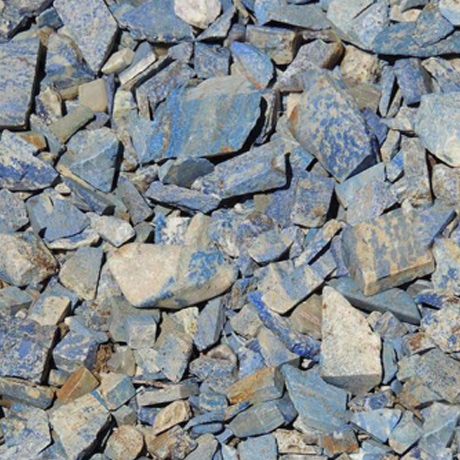Cobalt
Basic facts about Cobalt :
Cobalt is a chemical element with the symbol Co and atomic number 27. Like nickel, cobalt is found in the Earth's crust only in chemically combined form, save for small deposits found in alloys of natural meteoric iron. The free element, produced by reductive smelting, is a hard, lustrous, silver-greyish blue metal. Like iron, it can be magnetized. It is similar to iron and nickel in its physical properties. Cobalt is one of the three metals that are ferromagnetic at room temperature. The word cobalt is derived from the German kobalt, from kobold meaning "goblin", a superstitious term used for the ore of cobalt by miners.
The element is active chemically, forming many compounds. Cobalt is stable in air and unaffected by water, It dissolves slowly in dilute mineral acids, does not combine directly with either hydrogen or nitrogen, but will combine, on heating, with carbon, phosphorus, or sulphur. Cobalt is also attacked by oxygen and by water vapour at elevated temperatures, with the result that cobaltous oxide, CoO .Most of the Earth's cobalt is in its core. Cobalt is of relatively low abundance in the Earth's crust and in natural waters, from which it is precipitated as the highly insoluble cobalt sulfine CoS. Most of the Earth's cobalt is in its core.
Cobalt is of relatively low abundance in the Earth's crust and in natural waters, from which it is precipitated as the highly insoluble cobalt sulfine CoS. Although the average level of cobalt in soils is 8 ppm, there are soils with as little as 0.1 ppm and others with as much as 70 ppm. In the marine environment cobalt is needed by blue-green algae (cyanobacteria) and other nitrogen fixing organisms.
Cobalt is not found as a free metal and is generally found in the form of ores. Cobalt is usually not mined alone, and tends to be produced as a by-product of nickel and copper mining activities. The main ores of cobalt are cobaltite, erythrite, glaucodot, and skutterudite.
Cobalt is primarily used in lithium-ion batteries, and in the manufacture of magnetic, wear-resistant and high-strength alloys. Cobalt is a ferromagnetic metal with a specific gravity of 8.9. A huge reserve of several transition metals (including cobalt) can be found in strange nodules on the floors of the deepest oceans. The nodules are manganese minerals that take millions of years to form, and together they contain many tonnes of cobalt. With few exceptions, cobalt ore is not usually mined for the cobalt content. Rather, it is often recovered as a by-product from the mining of ores of iron, nickel, copper, silver, manganese, zinc, and arsenic, which contain traces of cobalt.
APPLICATIONS OF COBALT :
- Cobalt, like iron, can be magnetised and so is used to make magnets. It is alloyed with aluminium and nickel to make particularly powerful magnets. It is used in magnets and magnetic recording media also.
- It acts as catalysts for the petroleum and chemical industries.
- It is used as drying agents for paints and inks. Cobalt blue is an important part of artists' palette and is used by craft workers in porcelain, pottery, stained glass, tiles and enamel jewellery. Cobalt salts have been used for centuries to produce brilliant blue colours in paint, porcelain, glass, pottery and enamels.
- The radioactive isotopes, cobalt-60, is used in medical treatment and also to irradiate food, in order to preserve the food and protect the consumer. This radiation is sometimes used with cancer-patients to destroy tumours. It is an important source of gamma-rays and is widely used in cancer treatment, as a tracer and for radiotherapy. Gamma radiation from cobalt-60 has been used in place of X-rays or alpha rays from radium in the inspection of industrial materials to reveal internal structure, flaws, or foreign objects.
- Cobalt is used in many alloys ,super alloys for parts in corrosion resistant alloys, high-speed steels, cemented carbide etc. Other alloys of cobalt are used in jet turbines and gas turbine generators, where high-temperature strength is important.
- Cobalt is an essential trace element, and forms part of the active site of vitamin B12. The amount we need is very small, and the body contains only about 1 milligram. Cobalt salts can be given to certain animals in small doses to correct mineral deficiencies.
- Cobalt – a metal used in batteries for electric vehicles and portable electronics. Cobalt metal is sometimes used in electroplating because of its attractive appearance, hardness and resistance to corrosion.
- Cobalt is the most satisfactory matrix for cemented carbides.
Chemical properties of Cobalt
| Atomic symbol | Co |
|---|---|
| Atomic number | 27 |
| Atomic Mass | 58.9332 g.mol-1 |
| Density | 8.90 g cm−3 |
| Melting Point | 1495°C |
| Boiling Point | 2927°C |
| Electrical Resistivity | 1.44 µΩ·m (at 20 °C) |
| Electron configuration | [Ar] 3d74s2 |
| Atomic radius empirical | 125pm |
| Mohs scale hardness | 5.0 |
| Electronegativity Pauling Scale | 1.88 |
| Thermal Expansion | 13.0µm/(m·K) (at 25 °C) |
| Thermal Conductivity | 100 W/(m·K) |
| Young's Modulus | 209 GPa |
| Bulk Modulus | 180 GPa |
